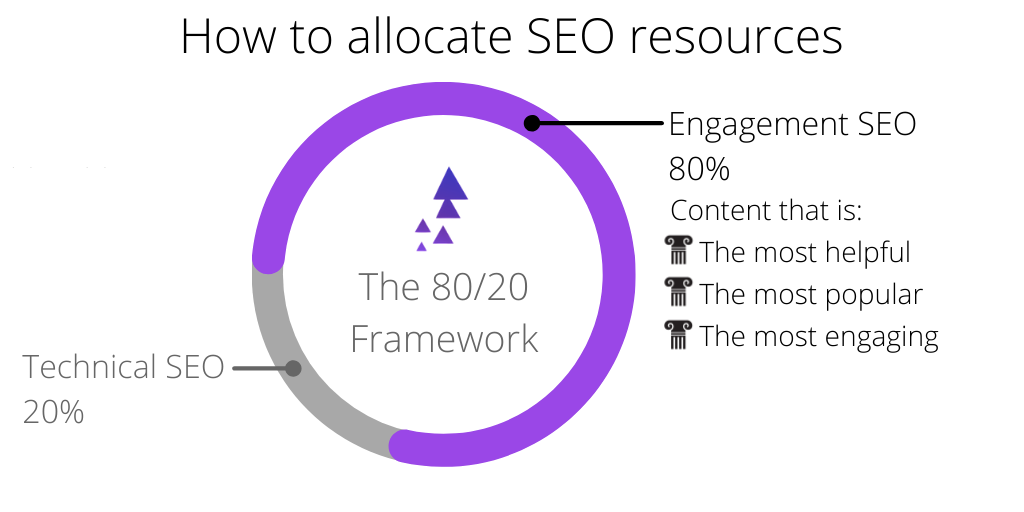Improving SEO: The Only Work that Really Matters
Often, the thought of SEO conjures up visions of code snippets and keyword density—the technical details that used to be the bulk of an SEO strategy. But how much does the technical side of SEO really impact results today? Do things like keyword density matter at all if your SEO strategy doesn’t focus on engagement?

Engagement SEO, a strategy that aims to deliver the best experience possible for search engine visitors, is more impactful in search ranking studies because it feeds Google the content they want to deliver. Search engines have evolved, and everyone is winning.
Balancing Technical and Engagement SEO
Technical SEO is a valuable piece of SEO. It’s the qualifier that gets you in the door, but it’s not the skill or strength that wins gold.
Technical factors like keyword density, strategic links, and clean code/URLs are necessary to help search engines find and understand your site. Any problems should be taken care of quickly, but then it’s time to move on. There will almost always be some technical SEO work that can be done, but most of it won’t really improve SEO metrics that the C-suite is interested in.

An impactful, modern SEO plan is about 20% technical considerations. The rest—a full 80%—should be focused entirely on user engagement.
Technical SEO Factors to Improve First
Some website issues can hold you back regardless of how well you SEO. This is especially true if your website is a few years old. Before you get started with your SEO plan (or as soon as possible if you’ve already started), make sure that these “red flag” issues are resolved:
- Mobile unfriendliness—Google’s algorithm strongly prefers mobile-compatible websites on mobile searches, and mobile search is growing. There are a lot of tools to help test and tweak this, but one of the best ways is to pull out your smartphone and browse your site.
- Slow load time—A slow page will lose engagement before you even get a chance to impress, making it difficult to move up in the page rankings. Optimize your CSS and images, enable browser caching, fix broken links, compress your site, etc.
- Crawlability and indexing—The search engine should be able to crawl through the website’s text and navigate easily without hitting dead ends. Take some time to click through your site, and make sure 404 errors are fixed or redirected.
- Search engine penalties—Past penalties can have an enduring effect. Moz’s guide can help.
Cleaning up these issues won’t catapult your landing page to #1, but ignoring them will keep you off of Page 1 no matter how great your user experience/engagement SEO is.
User Experience: Google Knows All!
Google’s #1 priority is user experience. And for good reason: when users are happy, ads space—by far Google’s greatest source of income—on their pages sells.
Google users were not happy when a widespread use of black hat SEO gave low-value and even outright spammy sites the highest rankings. (Neither were marketers who created genuinely worthy content that didn’t get rewarded.) Google evolved at a furious pace for years, until the recent announcement of a machine learning (basically artificial intelligence) program called RankBrain that updates Google’s algorithms 24/7. Google mastered the art of measuring high-quality content, and SEOs were forced to submit.
Today, Google knows what sites people engage with, and can tell when users are having a good experience. If a site is not giving users what they’re looking for, it will struggle in the rankings.
Big Picture SEO Strategies
Creating engagement is more complex than technical SEO, and requires more creativity. Marketers need to, in effect, get inside their demographics’ heads and anticipate their needs. It might sound impossible, but Google has already done the hard part for you:
- Understand user intent—If a user is searching for information, what might he or she want to know? Search results can be broken down into two main categories: informative and sales-ready. If a user Googles, “running shoes,” does she want to buy shoes or does she want to learn how to find the best kind for her lifestyle? Search your keywords, study the results, and then determine if your content strategy is answering the intent behind the search.
- Be unique—Don’t just mimic what other Page 1 results are doing. Use a different format, more engaging media, etc. Make sure your content stands out from the crowd.
- Be thorough—Have you ever searched for a way to fix something and landed on a page that offered no real help? It’s frustrating, and you don’t want to be that page. Answer anticipated questions clearly and thoroughly so they don’t need to look for something better.
Qualities of Effective Engagement SEO Work
Ready to get started? Lay out a strategy that utilizes both technical and engagement SEO, but weight it toward engagement. Remember, a strong SEO plan should be 20% technical and 80% engagement. That means the main focus will be on content, quality, and user interaction.
What is great content? It’s content that encompasses three key content goals:
- Most helpful—The best content specifically addresses the user’s need or pain point, and gives clear, actionable advice. But you can’t create this kind of content until you understand the user intent behind your target keywords, so back up.
- Most popular—Clicks, inbound links, mentions, and co-citations all determine content popularity. You can increase popularity by sharing content on social networks, sending it to your email list, and blogging about it. At the end of the day, however,what makes content popular is that it’s good enough that people want to share it themselves. Make a regular habit out of comparing the content that earns shares and links on its own with content that does not.
- Most engaging—Low bounce rate, high time-on-site, and satisfaction of users mark engaging content. This starts with hooking them, whether with an appealing headline or striking visuals, but that’s just the where it starts. Once you’ve got them, your content needs to keep them interested.
When these three goals are met, the desired results will follow. It takes work, focus, and commitment, but the payoff is far ahead of what you can expect using technical SEO alone.
3 Steps to Get Started with These Priorities
All SEO work is not created equal. A traditional, technically-oriented SEO consultant or agency can always find “SEO work” to do, but if it’s not based on engaging an audience, it won’t drive real results. Ready to get to work?
- Audit your technical SEO efforts. Get a report or sit with your team to look at the technical work that is being done and how much time is being spent on it. Prioritize the critical and high-value technical work, and consider pausing the low-impact work while you improve engagement SEO strategies and practices.
- Identify keyword and user intent for all of your content. For existing content, start with keywords that are already driving traffic, and where inbound links are coming from. You can tweak content to answer user intent even better. Set up a process for developing future content based on user intent research, so you know that all of your content is exactly what your audience is looking for.
- Improve engagement SEO efforts. Measure whether each piece of content is more helpful and more engaging than the competition’s, and that it is shared effectively on other channels. As you dig into user intent research, click through some of the best-ranked pages and consider what you can do better.
For a more detailed description of the qualities of effective engagement SEO, a step-by-step guide to developing your strategy, and a complete framework for modern SEO, check out our latest ebook: The CMO’s Guide to Modern SEO.
What's Next?
Profound Strategy is on a mission to help growth-minded marketers turn SEO back into a source of predictable, reliable, scalable business results.
Start winning in organic search and turn SEO into your most efficient marketing channel. Subscribe to updates and join the 6,000+ marketing executives and founders that are changing the way they do SEO:
And dig deeper with some of our best content, such as The CMO’s Guide to Modern SEO, Technical SEO: A Decision Maker’s Guide, and A Modern Framework for SEO Work that Matters.




